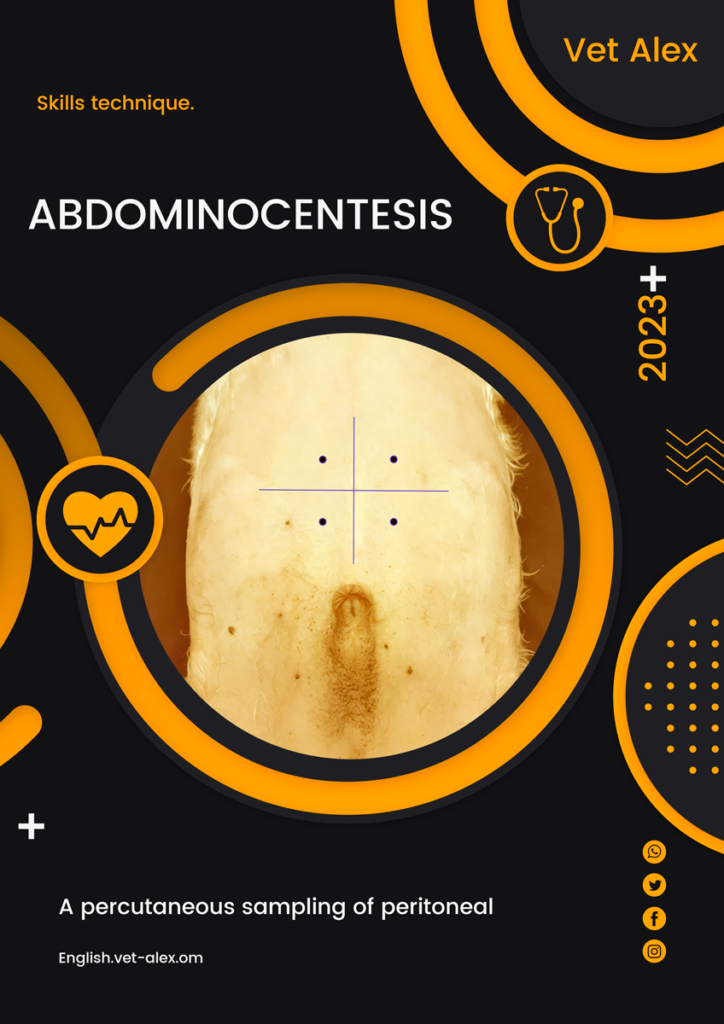A percutaneous sampling of peritoneal fluid with a needle or catheter and this technique comes with minimal risks and physical restrain is commonly enough.
Abdominocentesis in the veterinary field is a great skill for vets and students to know.
so we will talk today about Abdominocentesis as a clinical skill in cat , dog and even horse .
This technique targets both nurses and Vets.

Indications of Abdominocentesis .
Indications of abdomenocentesis include :
1. unexplained presence of free abdominal fluid.
2. removal of previously diagnosed fluid that is causing respiratory or digestive compromise.
What is Abdominocentesis ?
Abdominocentesis is a simple, rapid, and safe diagnostic method to take a sample from this fluid.
When physical examination or imaging indicates moderate to large amounts of peritoneal effusion in a patient, sampling the fluid for cytologic, microbiological, or biochemical analysis often helps the clinician to quickly make a diagnosis and then to initiate timely and appropriate therapy (1).
contraindications.
Take care when you perform this technique for :
- Coagulopathy.
- Marked organomegaly.
- or a disorder affecting a distended hollow organ (such as a pyometra) is suspected.
In these instances, consider ultrasound-guided sample collection if available.
Abdominocentesis is best performed after plain radiography unless a rapid diagnosis needs to be made in a deteriorating patient.
Free peritoneal air on radiographs may help the clinician identify hollow organ rupture or peritoneal perforation.
Fast Video on the topic.
Equipments.
you will need these materials to perform Abdominocentesis :
- Clippers and surgical scrub.
- Needles and syringes of appropriate size.
- Culturette.
- EDTA tubes “purple-top” (for cytology, total protein content, red blood cell and total nucleated cell count) .
- Serum tubes “red-top” (for biochemistry analysis) .
- ± glucometer.
- Culturettes for bacterial culture.
- Glass slides for cytologic evaluation.
The procedure of Abdominocentesis in pets.
The patient is typically placed in lateral recumbency.
The area surrounding the umbilicus is clipped and surgically prepared the ventral abdominal area for aseptic fluid collection.
Ultrasound can help greatly to detect the best place to insert the needles .
4 needles, without syringes attached, can be placed in the 4 quadrants surrounding the umbilicus. If fluid appears in the hub of one, it can be aspirated and samples obtained.
Video.
this Video is from external source.
Abdominocentesis in horse.
Abdominocentesis is a diagnostic technique for many species not only Dogs and Cats but it’s commonly used in horses with abdominal pain (colic).
Abdominal discomfort can occur in the post-foaling mare for a number of reasons including a primary gastrointestinal issue, uterine or broad ligament hematoma, secondary gastrointestinal issue, peritonitis due to vaginal, cervical, or uterine tear, urinary bladder rupture, or lesions in other abdominal organs.
Ultrasound should be used to guide abdominal paracentesis to locate fluid in the ventral abdomen. In addition, the characteristics and amount of peritoneal fluid should be noted.
Fluid obtained from abdominocentesis should be submitted to a diagnostic laboratory for gross, biochemical, and microscopic analysis. (4)
for further reading please see the reference number 4.
References:
(1) Clinician breif – https://www.cliniciansbrief.com/article/abdominocentesis#step-by-step-how-to-perform-abdominocentesis
(2) Small Animal Clinical Techniques, 3rd Edition by Susan Meric Taylor
(3) youtube channel Dr. Bassem Abdelmalek .
(4) Dascanio, J.J. (2021). Abdominocentesis. In Equine Reproductive Procedures (eds J. Dascanio and P. McCue). https://doi.org/10.1002/9781119556015.ch109